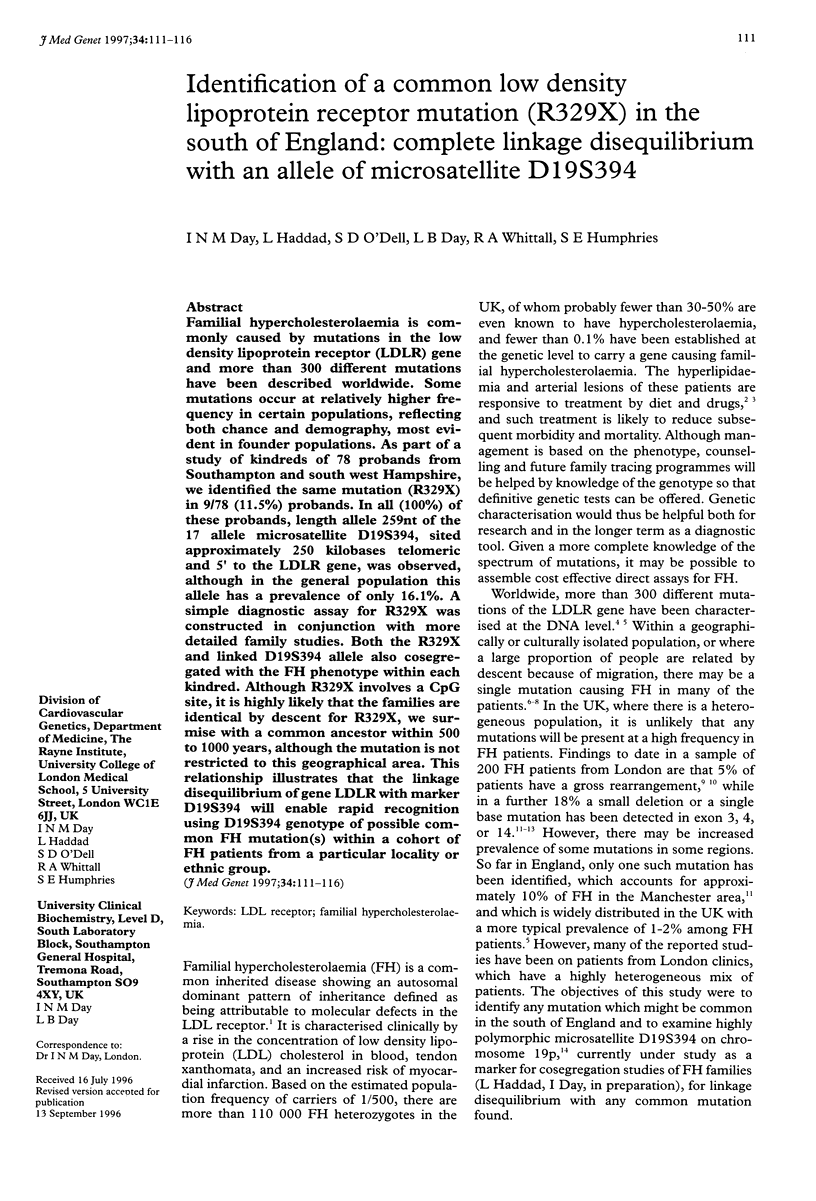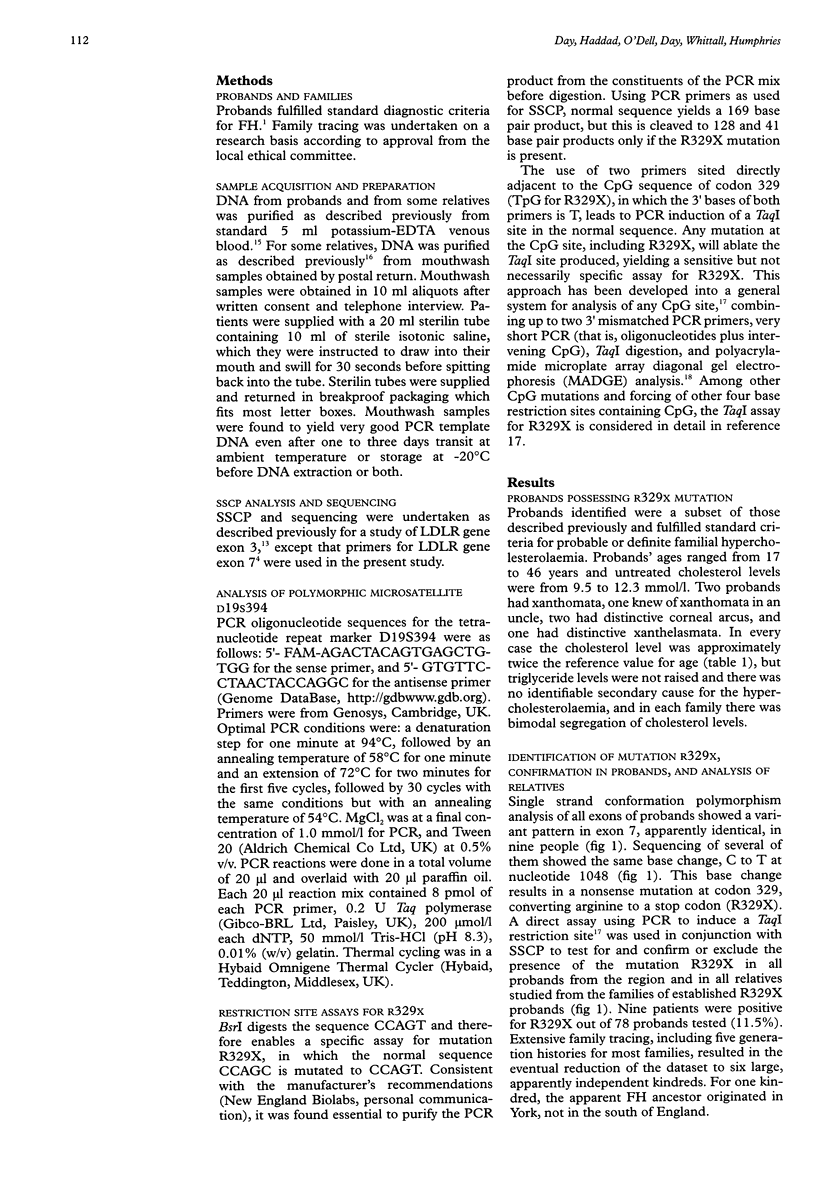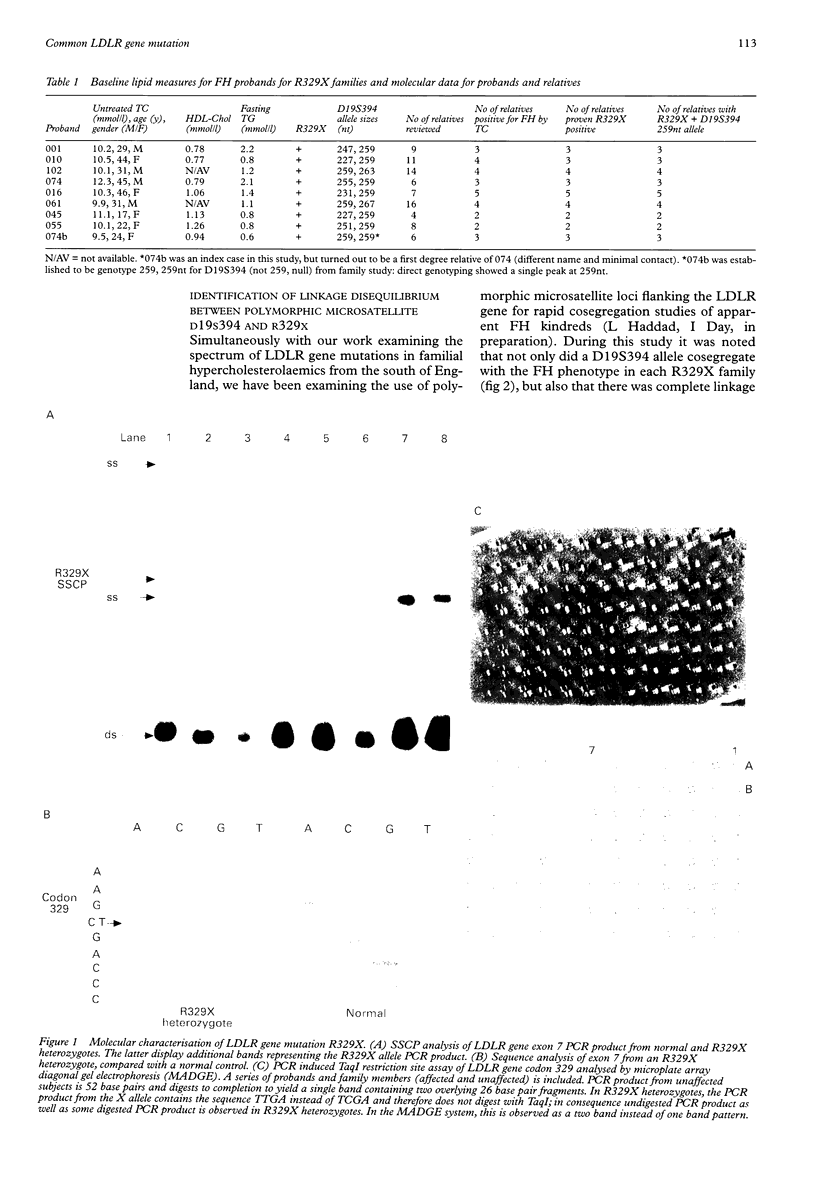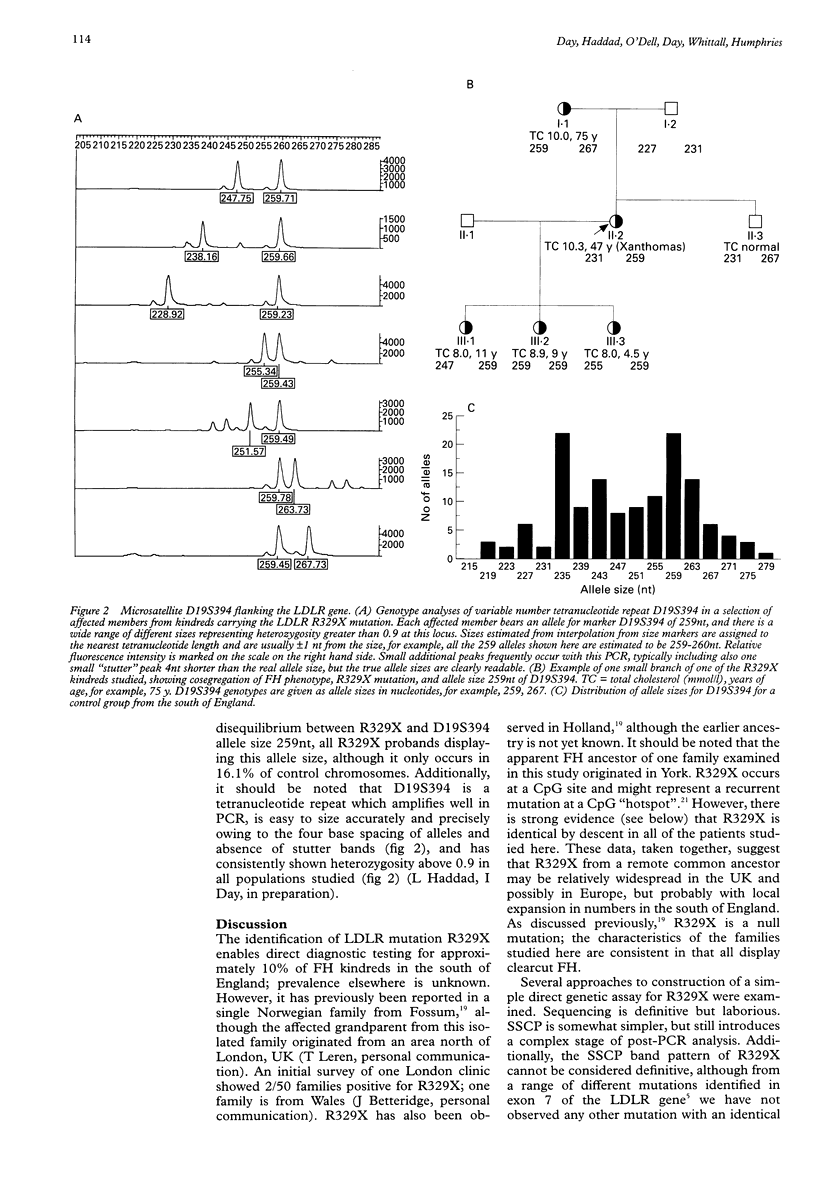Abstract
Familial hypercholesterolaemia is commonly caused by mutations in the low density lipoprotein receptor (LDLR) gene and more than 300 different mutations have been described worldwide. Some mutations occur at relatively higher frequency in certain populations, reflecting both chance and demography, most evident in founder populations. As part of a study of kindreds of 78 probands from Southampton and south west Hampshire, we identified the same mutation (R329X) in 9/78 (11.5%) probands. In all (100%) of these probands, length allele 259nt of the 17 allele microsatellite D19S394, sited approximately 250 kilobases telomeric and 5' to the LDLR gene, was observed, although in the general population this allele has a prevalence of only 16.1%. A simple diagnostic assay for R329X was constructed in conjunction with more detailed family studies. Both the R329X and linked D19S394 allele also cosegregated with the FH phenotype within each kindred. Although R329X involves a CpG site, it is highly likely that the families are identical by descent for R329X, we surmise with a common ancestor within 500 to 1000 years, although the mutation is not restricted to this geographical area. This relationship illustrates that the linkage disequilibrium of gene LDLR with marker D19S394 will enable rapid recognition using D19S394 genotype of possible common FH mutation(s) within a cohort of FH patients from a particular locality or ethnic group.
Full text
PDF





Images in this article
Selected References
These references are in PubMed. This may not be the complete list of references from this article.
- Ashworth L. K., Batzer M. A., Brandriff B., Branscomb E., de Jong P., Garcia E., Garnes J. A., Gordon L. A., Lamerdin J. E., Lennon G. An integrated metric physical map of human chromosome 19. Nat Genet. 1995 Dec;11(4):422–427. doi: 10.1038/ng1295-422. [DOI] [PubMed] [Google Scholar]
- Bolla M. K., Haddad L., Humphries S. E., Winder A. F., Day I. N. High-throughput method for determination of apolipoprotein E genotypes with use of restriction digestion analysis by microplate array diagonal gel electrophoresis. Clin Chem. 1995 Nov;41(11):1599–1604. [PubMed] [Google Scholar]
- Curtis L. D., Dickson A. C., Ling K. L., Betteridge J. Combination treatment with cholestyramine and bezafibrate for heterozygous familial hypercholesterolaemia. BMJ. 1988 Jul 16;297(6642):173–175. doi: 10.1136/bmj.297.6642.173. [DOI] [PMC free article] [PubMed] [Google Scholar]
- Day I. N., Humphries S. E. Electrophoresis for genotyping: microtiter array diagonal gel electrophoresis on horizontal polyacrylamide gels, hydrolink, or agarose. Anal Biochem. 1994 Nov 1;222(2):389–395. doi: 10.1006/abio.1994.1507. [DOI] [PubMed] [Google Scholar]
- Gudnason V., King-Underwood L., Seed M., Sun X. M., Soutar A. K., Humphries S. E. Identification of recurrent and novel mutations in exon 4 of the LDL receptor gene in patients with familial hypercholesterolemia in the United Kingdom. Arterioscler Thromb. 1993 Jan;13(1):56–63. doi: 10.1161/01.atv.13.1.56. [DOI] [PubMed] [Google Scholar]
- Hobbs H. H., Brown M. S., Goldstein J. L. Molecular genetics of the LDL receptor gene in familial hypercholesterolemia. Hum Mutat. 1992;1(6):445–466. doi: 10.1002/humu.1380010602. [DOI] [PubMed] [Google Scholar]
- Horsthemke B., Dunning A., Humphries S. Identification of deletions in the human low density lipoprotein receptor gene. J Med Genet. 1987 Mar;24(3):144–147. doi: 10.1136/jmg.24.3.144. [DOI] [PMC free article] [PubMed] [Google Scholar]
- Kane J. P., Malloy M. J., Ports T. A., Phillips N. R., Diehl J. C., Havel R. J. Regression of coronary atherosclerosis during treatment of familial hypercholesterolemia with combined drug regimens. JAMA. 1990 Dec 19;264(23):3007–3012. [PubMed] [Google Scholar]
- King-Underwood L., Gudnason V., Humphries S., Seed M., Patel D., Knight B., Soutar A. Identification of the 664 proline to leucine mutation in the low density lipoprotein receptor in four unrelated patients with familial hypercholesterolaemia in the UK. Clin Genet. 1991 Jul;40(1):17–28. doi: 10.1111/j.1399-0004.1991.tb03064.x. [DOI] [PubMed] [Google Scholar]
- Koivisto U. M., Turtola H., Aalto-Setälä K., Top B., Frants R. R., Kovanen P. T., Syvänen A. C., Kontula K. The familial hypercholesterolemia (FH)-North Karelia mutation of the low density lipoprotein receptor gene deletes seven nucleotides of exon 6 and is a common cause of FH in Finland. J Clin Invest. 1992 Jul;90(1):219–228. doi: 10.1172/JCI115839. [DOI] [PMC free article] [PubMed] [Google Scholar]
- Leitersdorf E., Tobin E. J., Davignon J., Hobbs H. H. Common low-density lipoprotein receptor mutations in the French Canadian population. J Clin Invest. 1990 Apr;85(4):1014–1023. doi: 10.1172/JCI114531. [DOI] [PMC free article] [PubMed] [Google Scholar]
- Leitersdorf E., Van der Westhuyzen D. R., Coetzee G. A., Hobbs H. H. Two common low density lipoprotein receptor gene mutations cause familial hypercholesterolemia in Afrikaners. J Clin Invest. 1989 Sep;84(3):954–961. doi: 10.1172/JCI114258. [DOI] [PMC free article] [PubMed] [Google Scholar]
- Leren T. P., Solberg K., Rødningen O. K., Tonstad S., Ose L. Two founder mutations in the LDL receptor gene in Norwegian familial hypercholesterolemia subjects. Atherosclerosis. 1994 Dec;111(2):175–182. doi: 10.1016/0021-9150(94)90091-4. [DOI] [PubMed] [Google Scholar]
- Lombardi P., Sijbrands E. J., van de Giessen K., Smelt A. H., Kastelein J. J., Frants R. R., Havekes L. M. Mutations in the low density lipoprotein receptor gene of familial hypercholesterolemic patients detected by denaturing gradient gel electrophoresis and direct sequencing. J Lipid Res. 1995 Apr;36(4):860–867. [PubMed] [Google Scholar]
- Murray J. C., Buetow K. H., Weber J. L., Ludwigsen S., Scherpbier-Heddema T., Manion F., Quillen J., Sheffield V. C., Sunden S., Duyk G. M. A comprehensive human linkage map with centimorgan density. Cooperative Human Linkage Center (CHLC). Science. 1994 Sep 30;265(5181):2049–2054. doi: 10.1126/science.8091227. [DOI] [PubMed] [Google Scholar]
- Solberg K., Rødningen O. K., Tonstad S., Ose L., Leren T. P. Familial hypercholesterolaemia caused by a non-sense mutation in codon 329 of the LDL receptor gene. Scand J Clin Lab Invest. 1994 Dec;54(8):605–609. doi: 10.3109/00365519409087539. [DOI] [PubMed] [Google Scholar]
- Sun X. M., Webb J. C., Gudnason V., Humphries S., Seed M., Thompson G. R., Knight B. L., Soutar A. K. Characterization of deletions in the LDL receptor gene in patients with familial hypercholesterolemia in the United Kingdom. Arterioscler Thromb. 1992 Jul;12(7):762–770. doi: 10.1161/01.atv.12.7.762. [DOI] [PubMed] [Google Scholar]
- Webb J. C., Sun X. M., Patel D. D., McCarthy S. N., Knight B. L., Soutar A. K. Characterization of two new point mutations in the low density lipoprotein receptor genes of an English patient with homozygous familial hypercholesterolemia. J Lipid Res. 1992 May;33(5):689–698. [PubMed] [Google Scholar]
- Whittall R., Gudnason V., Weavind G. P., Day L. B., Humphries S. E., Day I. N. Utilities for high throughput use of the single strand conformational polymorphism method: screening of 791 patients with familial hypercholesterolaemia for mutations in exon 3 of the low density lipoprotein receptor gene. J Med Genet. 1995 Jul;32(7):509–515. doi: 10.1136/jmg.32.7.509. [DOI] [PMC free article] [PubMed] [Google Scholar]



